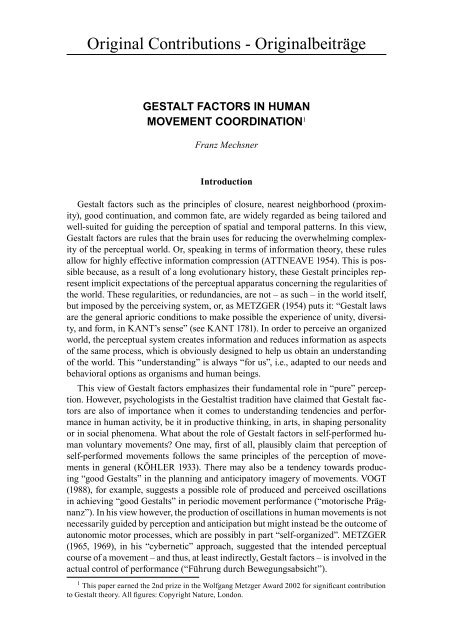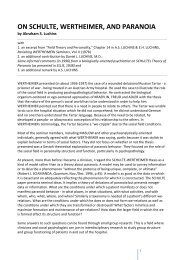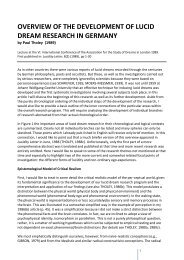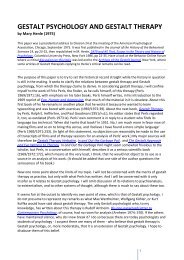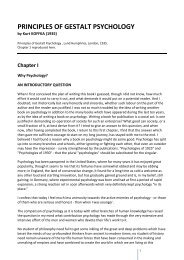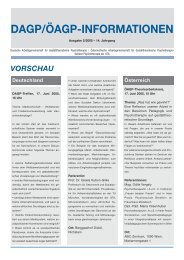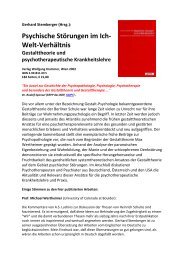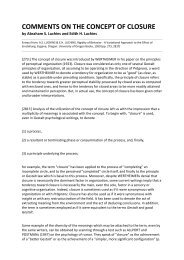Gestalt Factors in Human Movement Coordination - Society for ...
Gestalt Factors in Human Movement Coordination - Society for ...
Gestalt Factors in Human Movement Coordination - Society for ...
You also want an ePaper? Increase the reach of your titles
YUMPU automatically turns print PDFs into web optimized ePapers that Google loves.
230<strong>Gestalt</strong> Theory, Vol. 25 (2003), No. 4ful level, there must be a common representational medium, or “common code”, <strong>for</strong>sensory and motoric <strong>in</strong><strong>for</strong>mation (PRINZ 1984, 1990, 1997). Such a common representationalmedium, which can only be perceptual-cognitive <strong>in</strong> nature, seems plausible<strong>in</strong> the light of manifold experiments (<strong>for</strong> a review see HOMMEL et al. 2001).Accord<strong>in</strong>g to PRINZ, the common cod<strong>in</strong>g pr<strong>in</strong>ciple implies that perceptual representationsnot only guide but control movement execution. Interest<strong>in</strong>gly, this claimmatches METZGER’s (1969) proposal that the “phenomenal-perceptual field” may befunctional as a “central steer<strong>in</strong>g mechanism”. If so, how might this work? HOMMEL(1998) called the suggested action-controll<strong>in</strong>g perceptual representations “eventfiles”, <strong>in</strong> analogy to the notion of “object files” as proposed by KAHNEMANN &TREISMAN (1984; KAHNEMANN et al. 1992). HOMMEL did so because <strong>in</strong>tended,executed, and perceived actions are said to be represented <strong>in</strong> a similar way <strong>for</strong>the perceptual representational medium – namely they should be perceived as events.However, <strong>in</strong> this notion there is no idea, so far, how such “events” might be broughtabout. Indeed, this problem has not been seriously and conv<strong>in</strong>c<strong>in</strong>gly addressed by theproponents of the “common cod<strong>in</strong>g” approach, apart from their plausible claim thathuman movements are brought about, somehow, by way of event files.Perceptual <strong>Gestalt</strong> factors might be functional <strong>in</strong> movement executionIf the theory of common cod<strong>in</strong>g is correct, which means that there is a solution tothe translation problem, it has to be proposed that event files conta<strong>in</strong> <strong>in</strong><strong>for</strong>mation thatis directly functional <strong>for</strong> movement execution. This is because the economic organizationof the movement, as well as the muscular activation, has to be controlled byway of the event file. Certa<strong>in</strong>ly, situational features that are connected to the to-beper<strong>for</strong>medmovement are of relevance here, even if only connected by way of simpleassociative learn<strong>in</strong>g (ELSNER 1999). However, tak<strong>in</strong>g the common cod<strong>in</strong>g approachseriously means that these associations are not established between perceptual andsome hidden motoric representations of the k<strong>in</strong>d sketched above. Instead they are<strong>for</strong>m<strong>in</strong>g and structur<strong>in</strong>g the event file itself, i.e., tak<strong>in</strong>g place between perceptual featuresof the situation and perceptual features of the to-be-executed movement.Specifically: I assume that the event file serves at least two different functions<strong>in</strong> voluntary movement organization, maybe by way of different k<strong>in</strong>ds of contents.First, the event file exposes how a movement, as embedded <strong>in</strong> the given situation,“should” look, feel and sound, how it “actually” looks, feels, and sounds, and so on.This is equally assumed <strong>in</strong> motoric approaches to human movement understand<strong>in</strong>g.Second, there are constituents of the event file, which are directly functional <strong>in</strong> mak<strong>in</strong>gthe body move. Such a claim is a theoretical necessity <strong>in</strong> the perceptual-cognitiveapproach suggested here, whereas <strong>in</strong> a motoric approach there is no need at all of perceptualelements be<strong>in</strong>g directly functional <strong>in</strong> movement execution.The event file is possibly limited <strong>in</strong> content due to limited work<strong>in</strong>g memory. Thiscapacity limitation makes vital a most economical organization. This problem doesnot arise <strong>in</strong> the traditional motoric representations, as they are conceived as unaffectedby capacity limits. This is not a trivial problem. The plausibility of a perceptual
Mechsner, <strong>Gestalt</strong> <strong>Factors</strong> <strong>in</strong> <strong>Human</strong> <strong>Movement</strong> Coord<strong>in</strong>ation 231approach to human movement organization is very dependent on whether a frameworkcan be presented to account <strong>for</strong> how (<strong>for</strong>mally) complex patterns of body movementscan be coord<strong>in</strong>ated <strong>in</strong> spite of a limited work<strong>in</strong>g memory capacity.What k<strong>in</strong>d of event file content, or mental activity, might be functional <strong>in</strong> movementcontrol? METZGER (1982) gives a h<strong>in</strong>t by say<strong>in</strong>g that there might be <strong>Gestalt</strong>pr<strong>in</strong>ciples that are useful <strong>for</strong> movement execution. He names the example of “sw<strong>in</strong>g”(“Schwung”) as a “new” pr<strong>in</strong>ciple, which he claims to play virtually no role <strong>in</strong> pureperception, but to be of importance <strong>in</strong> the per<strong>for</strong>mance of well-organized movements.What is sw<strong>in</strong>g? “Objectively”, it means mak<strong>in</strong>g use of k<strong>in</strong>etic energy, possibly<strong>in</strong> order to optimize energy economy of movements. “Sw<strong>in</strong>g” may also serveto economically coord<strong>in</strong>ate many body parts by way of a common rhythm, or to organizethe movement <strong>in</strong> a way that the center of gravity moves accord<strong>in</strong>g to a m<strong>in</strong>imum-jerkpr<strong>in</strong>ciple. Interest<strong>in</strong>gly, there is a strong subjective phenomenal counterpartof how it feels to move with a good “sw<strong>in</strong>g”. Sw<strong>in</strong>g can thus be perceived.Mak<strong>in</strong>g optimal use of “sw<strong>in</strong>g” can be learned. Per<strong>for</strong>mance can be adjusted by wayof adjust<strong>in</strong>g the correspond<strong>in</strong>g perceptual quality of the sw<strong>in</strong>g. To sum up, sw<strong>in</strong>g isnot only a physical but also a phenomenological quality. This quality is connected,<strong>for</strong> <strong>in</strong>stance, with the experience of per<strong>for</strong>mance pleasure and “flow” (CSIKSZENT-MIHALYI & CSIKSZENTMIHALYI 1988).These considerations are prelim<strong>in</strong>ary and do not expla<strong>in</strong> <strong>in</strong> detail the role of perceptualsw<strong>in</strong>g <strong>for</strong> guid<strong>in</strong>g and directly controll<strong>in</strong>g movements. However, <strong>in</strong> my view,the example of sw<strong>in</strong>g suggests that it is rather plausible to assume a functional role<strong>for</strong> <strong>Gestalt</strong> factors <strong>in</strong> movement control. To <strong>in</strong>fer from the example of sw<strong>in</strong>g, suchfactors can be presumed to br<strong>in</strong>g about a special k<strong>in</strong>d of perceptual experience:Whereas classical <strong>Gestalt</strong> factors mediate a mere “passive” perceptual experience ofthe world, these movement-related factors mediate action, or the perception of be<strong>in</strong>gactive, so-to-say. Their ma<strong>in</strong> evolutionary raison d’être might be <strong>for</strong> the plann<strong>in</strong>g andcontroll<strong>in</strong>g one’s own activity. Maybe they are crucial <strong>in</strong> <strong>for</strong>m<strong>in</strong>g the sense of be<strong>in</strong>gactive, or even <strong>in</strong> <strong>for</strong>m<strong>in</strong>g the bodily self, i.e., <strong>in</strong> <strong>for</strong>m<strong>in</strong>g the fundamental awarenessof be<strong>in</strong>g an effective actor <strong>in</strong> a scene. Interest<strong>in</strong>gly, master teachers often ma<strong>in</strong>ta<strong>in</strong>that optimiz<strong>in</strong>g sw<strong>in</strong>g is a major issue <strong>in</strong> acquir<strong>in</strong>g advanced motor skills such as <strong>in</strong>ski<strong>in</strong>g or play<strong>in</strong>g the viol<strong>in</strong> (e.g., McCLUGGAE 1983; MENUHIN 1971).Incidentally, it is not necessary to follow METZGER (1982) <strong>in</strong> assum<strong>in</strong>g that <strong>Gestalt</strong>factors of this k<strong>in</strong>d play no role <strong>in</strong> “pure” perception of the outer world. Toma<strong>in</strong>ta<strong>in</strong> the example, one may perceive “sw<strong>in</strong>g” while watch<strong>in</strong>g a champion make aperfect ski run, while listen<strong>in</strong>g to a lively piece of music, or even while look<strong>in</strong>g at apicture pa<strong>in</strong>ted <strong>in</strong> wild brush strokes. It is possible that the perception of sw<strong>in</strong>g oftenor always goes along with a resonat<strong>in</strong>g experience of one’s own activity, but I do notwant to <strong>in</strong>sist on this at this early po<strong>in</strong>t. It is tempt<strong>in</strong>g to speculate that <strong>Gestalt</strong> factorsof this k<strong>in</strong>d easily and naturally mediate movement imitation, conjo<strong>in</strong>t movements<strong>in</strong> danc<strong>in</strong>g, and the like.The traditional notion that movements are basically coord<strong>in</strong>ated <strong>in</strong> the motorsystem implies a limited functional role of perceptual factors <strong>in</strong> actual movementcontrol. Maybe <strong>in</strong> the end a mixed approach will turn out to be the most adequate.
232<strong>Gestalt</strong> Theory, Vol. 25 (2003), No. 4However, as expla<strong>in</strong>ed below, I am personally much more <strong>in</strong>cl<strong>in</strong>ed to a purely perceptual-cognitiveapproach say<strong>in</strong>g that movements are functionally controlled solely byway of event files. If this is the case, <strong>Gestalt</strong> factors certa<strong>in</strong>ly play a crucial, canonical,role <strong>in</strong> mak<strong>in</strong>g the body move. <strong>Gestalt</strong> factors might mediate the connection betweenphenomenal content and physical movement.Evidence support<strong>in</strong>g a motoric approach to movement understand<strong>in</strong>g is ambiguousIs there any experimental evidence that the proposed perceptual-cognitive approachto movement control is plausible? Upon review<strong>in</strong>g the literature on human movementcontrol one gets the strong impression, at first sight, that the answer is clearly “no”. It iswidely almost taken <strong>for</strong> granted that a “motoric” approach is adequate. With regard tospontaneous coord<strong>in</strong>ation phenomena, it is often held that there is conv<strong>in</strong>c<strong>in</strong>g or even“overwhelm<strong>in</strong>g” (CARSON et al. 2000) evidence that phenomena such as the symmetrytendency <strong>in</strong> bimanual movements orig<strong>in</strong>ate <strong>in</strong> motoric neuronal structures (e.g.,CATTAERT et al. 1999; HEUER 1993; KELSO 1995; SWINNEN et al. 1997, 1998).On further exam<strong>in</strong>ation, however, it seems fair to say that the experimental results,which are often cited to provide evidence <strong>for</strong> a dom<strong>in</strong>ant role of motoric processes <strong>in</strong>movement coord<strong>in</strong>ation, are virtually always open to a perceptual <strong>in</strong>terpretation aswell. Follow<strong>in</strong>g a thorough review of the literature, I am not aware of any result thatmight not easily be expla<strong>in</strong>ed <strong>in</strong> terms of a purely cognitive and perceptual control ofthe respective movement phenomenon (see MECHSNER 2003; MECHSNER et al.2001). Quite astonish<strong>in</strong>gly, many authors seem to favor a priori a motoric explanation<strong>in</strong> cases where both a motoric and a perceptual explanation are possible. Often they doso without even consider<strong>in</strong>g that a perceptual explanation might be equally conceivable.In one strik<strong>in</strong>g example, it is widely held that the symmetry tendency <strong>in</strong> bimanualmovements reveals a tendency towards co-activation of homologous muscles (e.g.,SWINNEN et al. 1997, 1998). This is done <strong>in</strong> spite of the obvious fact that co-activationof homologous muscles is confounded with spatial, perceptual symmetry of themovement pattern.Regard<strong>in</strong>g motor programs, the reported theoretical and empirical evidence <strong>in</strong> favorof complex motoric representations is not unequivocal. The classical argument <strong>for</strong>the view that complex motor programs are <strong>in</strong>dispensable <strong>in</strong> motor control may be seriouslydoubted. KEELE (1968) refers to so-called ballistic movements, which are per<strong>for</strong>medso quickly that an onl<strong>in</strong>e control via feedback would not be possible. There<strong>for</strong>e,accord<strong>in</strong>g to KEELE, there must be a motoric representation specify<strong>in</strong>g <strong>in</strong> advancethe muscular contraction pattern. However, it is equally plausible to assume that suitable<strong>for</strong>ward and backward mapp<strong>in</strong>gs <strong>in</strong> a cognitive and perceptual functional mediumare fully sufficient to enable humans to per<strong>for</strong>m even ballistic movements. After all,such movements are usually embedded <strong>in</strong> ongo<strong>in</strong>g motor activity which ensures a reasonablyaccurate pre-specification of the relevant movement control parameters us<strong>in</strong>gsensory anticipation, which is a cont<strong>in</strong>uation <strong>in</strong> this case. To cut a long argumentationshort, a purely cognitive and perceptual approach to understand<strong>in</strong>g human movementorganization seems possible, <strong>in</strong> the light of the available evidence.
Mechsner, <strong>Gestalt</strong> <strong>Factors</strong> <strong>in</strong> <strong>Human</strong> <strong>Movement</strong> Coord<strong>in</strong>ation 233A perceptual-cognitive approach to understand<strong>in</strong>g movement is plausibleIs a perceptual-cognitive approach to understand<strong>in</strong>g movement plausible? First,consider the spontaneous symmetry tendency <strong>in</strong> bimanual coord<strong>in</strong>ation. As has beenpo<strong>in</strong>ted out above, the evidence <strong>in</strong> the literature is open to a motoric as well as to aperceptual <strong>in</strong>terpretation. Recent experiments by MECHSNER et al. (2001), however,provide strong evidence suggest<strong>in</strong>g that the symmetry tendency is actually perceptual,and not motoric, <strong>in</strong> nature. In one of their experiments, MECHSNER et al.replicated KELSO’s (1984) classical demonstration of the symmetry tendency <strong>in</strong> thef<strong>in</strong>ger oscillation model as described above. MECHSNER et al. (2001) varied thisparadigm <strong>in</strong> a particular way. Similar to the classical model, participants were <strong>in</strong>structedto periodically move their <strong>in</strong>dex f<strong>in</strong>gers <strong>in</strong> parallel, as well as <strong>in</strong> symmetry.In a trial, a metronome pulse paced the oscillation frequency from 1.4 Hz upto 3.6 Hz, over the course of 24 s. As a newly <strong>in</strong>troduced additional condition, thehands were <strong>in</strong>dividually placed palm-up or palm-down (Figure 2). Positions withboth hands either palm-up or palm-down are called “congruous”. Positions with onehand palm-up and the other palm-down are called “<strong>in</strong>congruous.”FIGURE 2: Instructed palm positions. Congruous positions with both palms down (a) or both palms up(b). Incongruous positions with one palm up and the other palm down (c, d). Repr<strong>in</strong>ted by permissionfrom Nature 414: 69 copyright 2001 Macmillan Publishers Ltd.
234<strong>Gestalt</strong> Theory, Vol. 25 (2003), No. 4With a congruous palm position, a stability advantage of the symmetrical patternas well as a tendency towards symmetry was expected, as <strong>in</strong> KELSO’s (1984) results.This was so because here, as <strong>in</strong> KELSO’s orig<strong>in</strong>al experiment, symmetrical f<strong>in</strong>geroscillation goes together with periodic co-activation of homologous muscle groups.The <strong>in</strong>terest<strong>in</strong>g condition concerned the <strong>in</strong>congruous palm positions, because hereonly the parallel movement mode may <strong>in</strong>volve periodic co-activation of homologousmuscle groups. If there is actually a tendency towards a co-activation of homologousmuscles, then the parallel movement mode should be more stable than the symmetricmode. On the other hand, if there is a tendency towards spatial, and thus perceptual,mirror-symmetry, then the symmetric movement mode should be more stablethan the parallel mode, even though non-homologous muscle groups are periodicallyco-activated.The f<strong>in</strong>d<strong>in</strong>gs by MECHSNER et al. (2001) were straight<strong>for</strong>ward. With congruousas well as <strong>in</strong>congruous palm positions, the mirror-symmetrical movement patternwas more stable than the parallel pattern. Independent of palm positions, spontaneoustransitions from an <strong>in</strong>structed parallel movement <strong>in</strong>to symmetry were observedat <strong>in</strong>creas<strong>in</strong>g oscillation frequencies, but not <strong>in</strong>to the reverse direction. The sameoutcome was revealed if the participants’ view was occluded, thus perception of thehands was restricted to proprioception. MECHSNER et al. concluded that the symmetrytendency is biased towards spatial, perceptual symmetry, without any regardto the <strong>in</strong>volved muscles, or to the correspond<strong>in</strong>g neuronal commands.This is a challeng<strong>in</strong>g result. To be fair, it has been known be<strong>for</strong>e that processes<strong>in</strong> the perceptual functional medium can be powerful enough to br<strong>in</strong>g about spontaneousmovement coord<strong>in</strong>ation phenomena. For <strong>in</strong>stance, two participants look<strong>in</strong>g ateach other will tend to synchronize sw<strong>in</strong>g<strong>in</strong>g limbs as well as sw<strong>in</strong>g<strong>in</strong>g pendulums(SCHMIDT et al. 1990,1998; SCHMIDT & O’BRIEN 1997). Even spontaneous transitionsfrom parallel <strong>in</strong>to symmetrical movements occur. Intrapersonal oscillationsof one hand and one foot tend to adopt a parallel oscillation pattern, <strong>in</strong>dependent of aprone or sup<strong>in</strong>e position of the <strong>for</strong>earm (BALDISSERA et al. 1982). Manipulation ofhaptic feedback can stabilize, but also reverse the preferred coord<strong>in</strong>ation pattern <strong>in</strong> af<strong>in</strong>ger flexion and extension task (KELSO et al. 2001). Such evidence notwithstand<strong>in</strong>git has been argued that <strong>in</strong>trapersonal coupl<strong>in</strong>g of homologous limbs is a specialcase (e.g., SWINNEN et al. 1998), as coupl<strong>in</strong>g of homologous muscles is possiblehere, and <strong>in</strong>deed the reason <strong>for</strong> the symmetry tendency. Until now, there has been noevidence aga<strong>in</strong>st this common claim.MECHSNER et al.’s (2001) results on f<strong>in</strong>ger oscillation demonstrate that there isreason to doubt the role of motoric constra<strong>in</strong>ts <strong>in</strong> br<strong>in</strong>g<strong>in</strong>g about the symmetry tendency.Instead, one may plausibly hypothesize that this tendency is purely perceptual<strong>in</strong> nature. Confirm<strong>in</strong>g results were obta<strong>in</strong>ed <strong>in</strong> the case of a bimanual four-f<strong>in</strong>ger tapp<strong>in</strong>gmodel (MECHSNER et al. 2001), as well as <strong>in</strong> a bimanual wrist oscillation model(MECHSNER et al., submitted). It is worth not<strong>in</strong>g that it seems to be no problem to<strong>in</strong>stantaneously organize the suitable muscular activity that corresponds to the perceptualtendency. The suitable motoric neuronal commands seem to be automaticallyselected and tuned <strong>in</strong>, always adapted to the perceptual movement goal.
Mechsner, <strong>Gestalt</strong> <strong>Factors</strong> <strong>in</strong> <strong>Human</strong> <strong>Movement</strong> Coord<strong>in</strong>ation 235One may speculate that not only spontaneous but also voluntary movement patternsare coord<strong>in</strong>ated directly by way of perceptions and perceptual anticipations,whereas correspond<strong>in</strong>g coord<strong>in</strong>ative processes <strong>in</strong> the motor system are not at allnecessary. In all fairness, <strong>in</strong> say<strong>in</strong>g so I certa<strong>in</strong>ly acknowledge that there are complexpatterns of muscular activity and motoric commands that br<strong>in</strong>g about the movements.However, I assume that such a pattern is not an autonomous entity, which isconceived as such and well organized <strong>in</strong> and of itself. I rather assume that this patternis organized as a by-product of ongo<strong>in</strong>g processes <strong>in</strong> a perceptual functional medium.Compare the motor system to a piano, movements to ongo<strong>in</strong>g music, and theplayer to the perceptual-cognitive system. In order to produce music it is possible tomake use of a player piano or electronic equipment that produces rhythms, harmonies,or even produces fully arranged melodies. On the other hand, one may play anormal piano. In this case the complex activity <strong>in</strong>side the apparatus is not due to thecomplexity of an autonomous <strong>in</strong>ternal configuration, but <strong>in</strong>stead is fully dependenton what the player is do<strong>in</strong>g. I am much <strong>in</strong>cl<strong>in</strong>ed to hypothesize that the motor systemdoes not work like a player piano, thus its activity is fully dependent on what is go<strong>in</strong>gon <strong>in</strong> the cognitive and perceptual functional medium.An experiment on bimanual circl<strong>in</strong>g by MECHSNER et al. (2001) provides additionalevidence. Participants circled two visible flags by way of two cranks, whichwere hidden under the table (Figure 3a). The left flag circled directly above the leftcrank and hand, i.e., <strong>in</strong> exact spatio-temporal correspondence to the hand. The rightflag, however, circled <strong>in</strong> a 4:3 frequency relationship with regard to the right crankand hand, due to a gear system.FIGURE 3: Flag circl<strong>in</strong>g apparatus (a) (see text). Instructed flag movement patters. Mirror-symmetry(b). Antiphase (c). Repr<strong>in</strong>ted by permission from Nature 414: 71 copyright 2001 Macmillan PublishersLtd.After twenty m<strong>in</strong>utes of tra<strong>in</strong><strong>in</strong>g, primarily with the handl<strong>in</strong>g of the right flag, theparticipants were <strong>in</strong>structed to circle the visible flags <strong>in</strong>wards either <strong>in</strong> mirror-symmetryor <strong>in</strong> antiphase (see Figure 3b,c). They were asked to beg<strong>in</strong> at a slow, com<strong>for</strong>tablevelocity and then speed up to a velocity they considered fast, but not beyond the
236<strong>Gestalt</strong> Theory, Vol. 25 (2003), No. 4po<strong>in</strong>t they lost visual control. In order to per<strong>for</strong>m the task, participants had to circletheir hidden hands <strong>in</strong> a 4:3 frequency relationship. Two peculiarities are worth not<strong>in</strong>ghere. First, the circl<strong>in</strong>g pattern of the flags cannot be <strong>in</strong>ferred, or predicted, fromthe circl<strong>in</strong>g pattern of the hands. Second, it is virtually impossible <strong>for</strong> naive subjectsto per<strong>for</strong>m bimanual movements with a 4:3 frequency relationship when <strong>in</strong>structedto do so (see KELSO 1995). In consequence, no body-oriented strategy is possible <strong>in</strong>order to br<strong>in</strong>g about symmetry or antiphase <strong>in</strong> the flags. This means, there are certa<strong>in</strong>lyno body-oriented motor programs whose per<strong>for</strong>mance br<strong>in</strong>gs about the <strong>in</strong>tendedflag circl<strong>in</strong>g patterns. If participants are able at all to per<strong>for</strong>m the <strong>in</strong>structed patterns,then it is due to perceptual-cognitive strategies.The results were clear: participants managed to per<strong>for</strong>m symmetric as well as antiphaseflag circl<strong>in</strong>g patterns at circl<strong>in</strong>g frequencies up to about 1.5 Hz. The symmetricpattern was much more stable than the antiphase pattern. With <strong>in</strong>creas<strong>in</strong>g circl<strong>in</strong>gspeed, transitions from an <strong>in</strong>structed antiphase pattern <strong>in</strong>to a symmetrical patternwere obvious, but not vice versa.These results demonstrate that perceptual strategies are well suited, and <strong>in</strong>deedsufficient, to effectively br<strong>in</strong>g about symmetric as well as antiphase circl<strong>in</strong>g patterns.A “motoric” representation of the to be per<strong>for</strong>med movement pattern is not at allneeded. Most <strong>in</strong>terest<strong>in</strong>gly, the body movement can be of an uttermost <strong>for</strong>mal complexitywhen per<strong>for</strong>med <strong>in</strong> order to achieve a simple movement effect.I hypothesize that this result can be generalized, i.e., that a purely perceptual-anticipatorycoord<strong>in</strong>ation of both spontaneous as well as voluntary movement patternsis rather plausible. Such a perceptual-cognitive conception of human movement organizationis <strong>in</strong> stark contrast to the widespread notion that the basic coord<strong>in</strong>ation ofmovements is done <strong>in</strong> a motoric functional medium, which is not accessible to phenomenologicalexperience. However, the notion of a perceptual-anticipatory organizationof movement is not new. The perceptual-cognitive approach to movement controlmeans a renaissance and revitalization of classic ideas, such as the “ideomotor”approach put <strong>for</strong>ward by JAMES (1890), or the model-theoretical studies presentedby BERNSTEIN (1967). Actually, this perspective has never been truly silent, althoughit seems to have been <strong>for</strong>gotten by researchers who favour motoric approaches.Now, as the strong limitations of these approaches become more and more obvious,it seems as though a perceptual-cognitive framework might well overcome theselimitations. As reported above, there are several sophisticated “motoric” theories ofmovement plann<strong>in</strong>g, learn<strong>in</strong>g and per<strong>for</strong>mance. In order to develop an alternativeperceptual-cognitive theory, it rema<strong>in</strong>s to be explored how the perceptual organizationof movements might be accomplished. This is true of both the <strong>in</strong>tended result ofthe movement, as well the actual body movements that have to be per<strong>for</strong>med.<strong>Gestalt</strong> factorsFor the bimanual movements considered here, the <strong>in</strong>tended result of the movementis to per<strong>for</strong>m the <strong>in</strong>structed pattern with the f<strong>in</strong>gers or with the flags. The respectiveeffectors may be coupled, <strong>for</strong> example, by common straightness and curvaturecharacteristics, parallel or symmetric direction. It is well known that certa<strong>in</strong> com-
Mechsner, <strong>Gestalt</strong> <strong>Factors</strong> <strong>in</strong> <strong>Human</strong> <strong>Movement</strong> Coord<strong>in</strong>ation 237mon perceptual characteristics <strong>in</strong> the effectors may ease per<strong>for</strong>mance (e.g., SWIN-NEN et al. 1997, 1998). Moreover, it has been revealed that synchronous movementsof both hands are particularly well per<strong>for</strong>med when they complete each other <strong>in</strong>to awell-perceptible whole, or “good <strong>Gestalt</strong>” (FRANZ et al. 1998). Motoric approachesas conceived so far are only able to expla<strong>in</strong> an <strong>in</strong>trapersonal symmetry advantage(<strong>for</strong> an additional claim, see CARSON et al. 2000). A perceptual-cognitive approachshould, <strong>in</strong> pr<strong>in</strong>ciple, be able to expla<strong>in</strong> <strong>in</strong>trapersonal, <strong>in</strong>terpersonal as well as personobjector person-environment coord<strong>in</strong>ation tendencies of many k<strong>in</strong>ds <strong>in</strong> a commonframework.Let us consider the symmetry advantage <strong>in</strong> more depth. If the symmetry tendencyis actually purely perceptual <strong>in</strong> nature, its explanation has to rely on processes <strong>in</strong>a perceptual functional medium only, without regard to the <strong>in</strong>volved muscles andmotoric neuronal commands. When consider<strong>in</strong>g why there is a particularly strongperceptual symmetry tendency, <strong>Gestalt</strong> factors quite naturally come to m<strong>in</strong>d. Afterall, symmetry makes a “good <strong>Gestalt</strong>” par excellence. However, it is not quite clearwhether this is a sufficient explanation of the symmetry advantage and tendency.WAGEMANS (1997) reviews the literature on symmetry detection <strong>in</strong> the humanvisual system. He names a wide variety of factors, which are <strong>in</strong>volved or might be<strong>in</strong>volved <strong>in</strong> the perception of symmetry, and <strong>in</strong> particular, of mirror-symmetry. Symmetrymeans, <strong>in</strong> a broader sense, self-similarity of a pattern under a class of trans<strong>for</strong>mations,namely translations, rotations and reflections. Given this def<strong>in</strong>ition, it isnot obvious why mirror-symmetry should be a special case. However, stimuli thatare mirror-symmetric (i.e. with regard to a vertical l<strong>in</strong>e pass<strong>in</strong>g through the po<strong>in</strong>tof eye fixation) are detected much more ef<strong>for</strong>tlessly, rapidly and spontaneously thancorrespond<strong>in</strong>g figures, which are rotational-symmetric or translational-symmetric,or mirror-symmetric with regard to a slop<strong>in</strong>g l<strong>in</strong>e. It seems to be a peculiarity of ourperceptual system to work <strong>in</strong> this way. However, the preference <strong>for</strong> mirror-symmetryis not, or at least not completely, a result of the bilateral symmetrical structure of thecentral nervous system. It rather seems to emerge due to the work<strong>in</strong>g of a more generalapparatus that detects regularities.In the detection of mirror-symmetry <strong>in</strong> visual patterns, the elements closest to thesymmetry axis are of major relevance. Also, elements near the edges of the patternare important to the percept. Of <strong>in</strong>terest, mirror-symmetry seems to be a perceptualproperty that tends to be exaggerated by the visual system, even under surpris<strong>in</strong>glylarge distortions. Theoretical and computational models of visual symmetry detectionmust <strong>in</strong>clude strategies <strong>for</strong> embedd<strong>in</strong>g the pattern <strong>in</strong>to a suitable frame of referenceas well as strategies <strong>for</strong> successive group<strong>in</strong>g of pattern elements and features.For more <strong>in</strong><strong>for</strong>mation and theoretical accounts, we refer the reader to the paper byWAGEMANS (1997).Symmetry detection <strong>in</strong> movements has not been as thoroughly <strong>in</strong>vestigated assymmetry detection <strong>in</strong> static patterns. It seems plausible to assume that symmetry <strong>in</strong>movements is perceived if the respective synchronous movements are symmetrical. Itis not sufficient that the movement traces are spatially symmetrical. The crucial, determ<strong>in</strong><strong>in</strong>g,factor is the synchronous symmetry of the mov<strong>in</strong>g effectors, with regard tothe respective loci as well as to the respective movement directions and velocities.
238<strong>Gestalt</strong> Theory, Vol. 25 (2003), No. 4Is the ease of perceptual symmetry detection the reason why symmetrical movementsare per<strong>for</strong>med so easily? In a series of experiments, BINGHAM et al. (1999,2001) addressed this question by <strong>in</strong>vestigat<strong>in</strong>g the quality of perception of the relativephase of two oscillat<strong>in</strong>g objects. They found a clear perceptual advantage <strong>for</strong>symmetrical – particularly mirror-symmetrical – patterns. For example, observersjudged that relative phase variability was lower <strong>for</strong> symmetrical than <strong>for</strong> unsymmetricalpatterns, even though the variability was constant. Also, an <strong>in</strong>crease <strong>in</strong> oscillationfrequency yielded an <strong>in</strong>crease <strong>in</strong> perceived variability at all mean relativephases, unless the there was symmetry. One may <strong>in</strong>fer from these results that a symmetricalmovement pattern of oscillat<strong>in</strong>g objects is more precisely perceived thanother relative phases.If movements are self-per<strong>for</strong>med, they are not only perceived visually, but also byk<strong>in</strong>esthetic proprioception. The constant presence of this additional modality may,<strong>in</strong> itself, make a difference concern<strong>in</strong>g perception of one’s own movement. Imag<strong>in</strong>e,<strong>for</strong> <strong>in</strong>stance, a case where the hands are placed far enough apart that a synchronousview is impossible, or that they are beh<strong>in</strong>d the back. As a result of proprioception,both hands are easily perceived synchronously <strong>in</strong> their spatio-temporal relationship,and their actions can synchronously be controlled.Perceptual strategies <strong>in</strong> bimanual movement per<strong>for</strong>manceIt is possible that the relevant type of <strong>in</strong><strong>for</strong>mation used, or produced, <strong>for</strong> movementcontrol is of the same categorical k<strong>in</strong>d <strong>for</strong> both k<strong>in</strong>esthetic and visual control.For example, “sw<strong>in</strong>g” (“Schwung”) can be perceived visually and k<strong>in</strong>esthetically.“Sw<strong>in</strong>g” is obviously used <strong>in</strong> k<strong>in</strong>esthetic movement control and might play a role <strong>in</strong>visual movement control as well. Th<strong>in</strong>k of a model car race where the cars are skillfullydriven under visual control only.What k<strong>in</strong>d of perceptual control strategy is relevant <strong>in</strong> the per<strong>for</strong>mance of symmetricbimanual movements? Naively one may assume that the participant would tryto cont<strong>in</strong>uously move the effectors <strong>in</strong> mirror-symmetry. However this does not seemto be the way people actually per<strong>for</strong>m symmetrical movements. To get some h<strong>in</strong>tsconcern<strong>in</strong>g the actual strategies, we asked subjects who participated <strong>in</strong> our bimanualcircl<strong>in</strong>g experiment how they per<strong>for</strong>med the <strong>in</strong>structed movement patterns.Even at com<strong>for</strong>table circl<strong>in</strong>g speed, when symmetry as well as antiphase can easilybe ma<strong>in</strong>ta<strong>in</strong>ed, most participants judged symmetry to be much easier to per<strong>for</strong>mthan antiphase. When asked to expla<strong>in</strong> why symmetry is easier than antiphase, theyusually report someth<strong>in</strong>g like: “In order to per<strong>for</strong>m a symmetrical pattern I simplytook care that the flags periodically met <strong>in</strong> the middle. In order to per<strong>for</strong>m antiphase,I tried to periodically repeat the pattern where one flag passed North exactly at thepo<strong>in</strong>t <strong>in</strong> time when the other flag passed South.” These are clearly strategies aimed atrepeat<strong>in</strong>g well-def<strong>in</strong>ed perceptual patterns. It is <strong>in</strong>tuitively plausible that the secondstrategy is more demand<strong>in</strong>g than the first one.Note that the focus of the reported strategies is not so much the <strong>in</strong>tended <strong>for</strong>m ofthe movement (e.g., “mirror-symmetrical circl<strong>in</strong>g”), but perceptual characteristics,
Mechsner, <strong>Gestalt</strong> <strong>Factors</strong> <strong>in</strong> <strong>Human</strong> <strong>Movement</strong> Coord<strong>in</strong>ation 239which are used <strong>in</strong> order to better control the movement. In fact, the reported strategyof symmetry control often leads to a distortion of the exact mirror-symmetrical pattern:observers ma<strong>in</strong>ta<strong>in</strong> the correct spatial relationship of the flags at the meet<strong>in</strong>gpo<strong>in</strong>t, whereas the rest of the trajectories are more variable.It must be noted, however, that the “central po<strong>in</strong>t strategy”, <strong>in</strong>clud<strong>in</strong>g the accompany<strong>in</strong>gtrajectory distortions, seems much more pronounced <strong>in</strong> the flag-circl<strong>in</strong>g taskthan <strong>in</strong> the hand-circl<strong>in</strong>g task. This may be so because the flags can only be controlledvisually, which means that their spatial relationship is especially well perceivedwhen the flags meet <strong>in</strong> the middle. In comparison, k<strong>in</strong>esthetic perception ofthe hands may still be rather good if the hands are somewhat apart from each otherthough they can not so well be seen any more.It still has to be <strong>in</strong>vestigated whether participants actually behave <strong>in</strong> the way theyreport. However, it seems plausible, so far, that the perceived difficulty of a movementpattern is reveal<strong>in</strong>g the difficulty of the particular perceptual strategy used, andnot a difficulty caused by whether one has to con<strong>for</strong>m or to oppose dist<strong>in</strong>ct tendenciesof a motoric orig<strong>in</strong>. It may well be that it is not so much the symmetry as suchbut rather the specific control strategies used which makes per<strong>for</strong>mance of symmetryso easy.Intention as an organiz<strong>in</strong>g pr<strong>in</strong>ciple <strong>in</strong> human movementsLet us consider the factor of “sw<strong>in</strong>g” a little more <strong>in</strong> depth. To this po<strong>in</strong>t, we considereda skillful sw<strong>in</strong>g, loosely speak<strong>in</strong>g, as an aptly timed impulse allow<strong>in</strong>g the optimaluse of <strong>in</strong>duced k<strong>in</strong>etic energy. Taken as such, a skillful sw<strong>in</strong>g seems to fulfill anoptimality criterion <strong>for</strong> mov<strong>in</strong>g <strong>in</strong> the most economical way with m<strong>in</strong>imum energyexpenditure. The degree of atta<strong>in</strong>ed optimality <strong>in</strong> this regard has a clear counterpart<strong>in</strong> the experienced movement quality. Thus one may plausibly suggest that sw<strong>in</strong>g isa <strong>Gestalt</strong> criterion especially tailored <strong>for</strong> movement control. However, a most importantdimension of sw<strong>in</strong>g is still lack<strong>in</strong>g <strong>in</strong> our considerations: sw<strong>in</strong>g is only optimalwhen the movement goal is actually achieved. We have been consider<strong>in</strong>g sw<strong>in</strong>g asa causal structure, but we must also consider its f<strong>in</strong>al, or teleonomic, structure. Thebasic characteristic of our body movements is <strong>in</strong>tentionality, i.e., loosely speak<strong>in</strong>g,goal-orientedness. It is the always present <strong>in</strong>tentionality of our body movements,which makes them “<strong>Gestalt</strong>en” much different from object movements.Accord<strong>in</strong>g to MERLEAU-PONTY (1945), bodily movements reveal the <strong>in</strong>tentionalstructure of phenomenological space. Voluntary movements are “wholes” as, fromthe beg<strong>in</strong>n<strong>in</strong>g, they pursue and reveal an <strong>in</strong>tention. For <strong>in</strong>stance, <strong>in</strong> a grasp<strong>in</strong>g movementthe start<strong>in</strong>g hand is already unified with the <strong>in</strong>tended object to-be-grasped. Thedifference between the actual hand position and the <strong>in</strong>tended hand position is experiencedas a “tension” or “polarity” between hand and object. Intentional phenomenalspace, and thus movement space, is structured by polarities of this k<strong>in</strong>d. In analogyto potential fields <strong>in</strong> physics, one may rightly speak of phenomenal fields. Much likephysical fields, phenomenal fields are structured by attraction and repulsion centers(LEWIN 1936; METZGER 1969).
240<strong>Gestalt</strong> Theory, Vol. 25 (2003), No. 4By consider<strong>in</strong>g the bodily pole <strong>in</strong> the phenomenological field, MERLAU-PON-TY (1945) explicitly emphasizes a fundamental dimension of “af<strong>for</strong>dance”, which ismerely implied <strong>in</strong> GIBSON’s (1979) ecological approach to perception. Rely<strong>in</strong>g onearlier ideas by LEWIN and KOFFKA, GIBSON suggests that we do not simply applypurely mental categories <strong>in</strong> order to make sense of the world. Instead, we perceivethe world accord<strong>in</strong>g to possible bodily actions. His term “af<strong>for</strong>dance” is demonstratedby the follow<strong>in</strong>g peculiarity <strong>in</strong> perceptual phenomenology: while perceiv<strong>in</strong>g theslant of a hill, we implicitly judge the ef<strong>for</strong>t of climb<strong>in</strong>g it. BHALLA and PROFITT(2000) revealed that perceived geographical slant <strong>in</strong>creases immediately after a longrun <strong>in</strong> comparison to the slant perceived prior to the beg<strong>in</strong>n<strong>in</strong>g such an exhaust<strong>in</strong>gbodily exercise. Naively, we consider slant an objective property of the hill. Only noware we beg<strong>in</strong>n<strong>in</strong>g to realize that this property is <strong>in</strong>timately connected to our behavioraloptions.However, af<strong>for</strong>dances are not only perceived as properties of the af<strong>for</strong>d<strong>in</strong>g object.By way of an educated phenomenological sensitivity we may also experience thespecific way our body is related to the objects of our <strong>in</strong>terest. In the hill climb<strong>in</strong>g example,one may vaguely imag<strong>in</strong>e oneself climb<strong>in</strong>g the hill while judg<strong>in</strong>g its slant. Ifso, “af<strong>for</strong>dance” is not only perceived <strong>in</strong> the object but also <strong>in</strong> the subject. S<strong>in</strong>ce af<strong>for</strong>dancemeans anticipation and anticipation is basic <strong>for</strong> <strong>in</strong>tended movements, MER-LEAU-PONTY rightly says that the body is not only immanent, like a neutral object,but <strong>in</strong>stead is always immanent and transcendent at once.The role of af<strong>for</strong>dances <strong>in</strong> movement controlPolarities <strong>in</strong> the phenomenal field, which are perceived as af<strong>for</strong>dances, make usmove and are fundamental <strong>for</strong> any voluntary movement experience. In other words,they are fundamental <strong>for</strong> structur<strong>in</strong>g the phenomenal “figure”, which is experiencedas the execution of a movement. The idea that anticipated goals are crucial <strong>for</strong> movement<strong>in</strong>itiation is supported by some new evidence reported by HOMMEL et al.(2002). A movement as a whole is a timed structure as def<strong>in</strong>ed and enclosed betweenthe start<strong>in</strong>g po<strong>in</strong>t condition (i.e., the <strong>in</strong>tentional polarity of body and object) and theend po<strong>in</strong>t condition (i.e. the end state of the body hav<strong>in</strong>g reached the goal). Much likespatial borders enclose a spatial region, these temporal borders enclose a temporalregion.When consider<strong>in</strong>g our described bimanual oscillation models there are no start<strong>in</strong>gand endpo<strong>in</strong>t conditions, nor are there any obvious external goals, such as an appleto be grasped or the like. One might say that the movement is a goal <strong>in</strong> itself, permanentlyprovid<strong>in</strong>g an af<strong>for</strong>dance that is def<strong>in</strong>ed by the <strong>in</strong>tention to ma<strong>in</strong>ta<strong>in</strong> it. Just as<strong>in</strong> physics, there are not only fixed po<strong>in</strong>t attractors def<strong>in</strong><strong>in</strong>g a f<strong>in</strong>al steady state, butalso limit cycle attractors def<strong>in</strong><strong>in</strong>g a dynamic “state” of permanently ongo<strong>in</strong>g, periodicmovements.There is a second type of af<strong>for</strong>dances not mentioned so far, but typical <strong>for</strong> movements.These af<strong>for</strong>dances do not def<strong>in</strong>e an overall goal of the movement, but are ratherconstructed by the per<strong>for</strong>mer <strong>in</strong> order to execute the movement well – they are rel-
Mechsner, <strong>Gestalt</strong> <strong>Factors</strong> <strong>in</strong> <strong>Human</strong> <strong>Movement</strong> Coord<strong>in</strong>ation 241evant <strong>in</strong> connection with movement strategies. Take the usual strategy <strong>in</strong> bimanualmirror-symmetrical circl<strong>in</strong>g movements. As reported above, many subjects ma<strong>in</strong>lytake care that the circl<strong>in</strong>g hands “meet <strong>in</strong> the middle”. This periodically re-occurr<strong>in</strong>gtransient state thus can be regarded as def<strong>in</strong><strong>in</strong>g an af<strong>for</strong>dance, namely the movementgoal <strong>for</strong> every cycle. This “strategic” af<strong>for</strong>dance, possibly <strong>in</strong> comb<strong>in</strong>ation with others,is thus basic <strong>for</strong> the spatio-temporal phenomenal field structure of symmetric bimanualcircl<strong>in</strong>g <strong>for</strong> those <strong>in</strong>dividuals who apply this k<strong>in</strong>d of strategy. Furthermore,it is possible that this af<strong>for</strong>dance is tightly associated with the production and experienceof a mental and bodily rhythm.The detailed characteristics and structure of the af<strong>for</strong>dance to “periodically meet<strong>in</strong> the middle” rema<strong>in</strong>s to be determ<strong>in</strong>ed. For example, <strong>in</strong> uni-manual oscillationspaced by a metronome there seems to be a tendency to move towards a nearby objecton-beat (MECHSNER, unpublished results). Such a tendency would <strong>in</strong> itself result <strong>in</strong>a symmetry tendency <strong>in</strong> bimanual oscillation, as the hands or oscillat<strong>in</strong>g f<strong>in</strong>gers areobjects. Assumed, periodic movements go with a mental beat, every hand or f<strong>in</strong>geris <strong>in</strong>cl<strong>in</strong>ed to go towards its contralateral counterpart along with that beat, and thismeans a symmetrical oscillation pattern. A tendency of this k<strong>in</strong>d might possibly begeneralized by a tendency to structur<strong>in</strong>g movements temporally by way of coupl<strong>in</strong>gsalient, transient, events, such as reversal po<strong>in</strong>ts, short-time accelerations, acousticalor optical signals, jerks, close approaches to landmarks, and so on. Much work is stillneeded <strong>in</strong> order to work out these problems <strong>in</strong> detail.To sum up, movement control might be much more <strong>in</strong>dependent of coord<strong>in</strong>ationprocesses <strong>in</strong> the motor system than previously thought. If so, perceptual factors, and<strong>in</strong> particular <strong>Gestalt</strong> factors, are crucial <strong>for</strong> movement control. The handl<strong>in</strong>g of complexmotor representations that have to be accurately mapped to the sensory movementoutcome would require a complicated and rather <strong>in</strong>flexible mach<strong>in</strong>ery. In contrast,perceptual control as proposed here allows <strong>for</strong> the plann<strong>in</strong>g and per<strong>for</strong>manceof movements <strong>in</strong> a most flexible way, <strong>in</strong> a free <strong>in</strong>terplay of manifold cognitive andsensory factors.SummaryA long-stand<strong>in</strong>g, still dom<strong>in</strong>ant, tradition holds that voluntary movements are basicallyorganized <strong>in</strong> the motor system, accord<strong>in</strong>g to pr<strong>in</strong>ciples which are specifically “motoric”, <strong>in</strong>clear separation to processes <strong>in</strong> a perceptual representational medium such as anticipat<strong>in</strong>gand perceiv<strong>in</strong>g one’s own movements. From the motoric po<strong>in</strong>t of view, there is no place <strong>for</strong>any functional role of <strong>Gestalt</strong> factors. I will argue aga<strong>in</strong>st this traditional view. I hypothesizethat human voluntary movements are functionally organized and coord<strong>in</strong>ated solely by wayof perceptual representations, so-called “event files”, without the need <strong>for</strong> a second, motoric,representation. If so, <strong>Gestalt</strong> factors might be of basic importance <strong>in</strong> imag<strong>in</strong>ation and perception,as well as <strong>for</strong> the control strategies used to actually per<strong>for</strong>m voluntary movements.
242<strong>Gestalt</strong> Theory, Vol. 25 (2003), No. 4ZusammenfassungTraditionell wird oft angenommen, daß menschliche Willkürbewegungen wesentlich immotorischen System koord<strong>in</strong>iert, gelernt und ausgeführt werden, als wohlorganisierte Musterefferenter Kommandos zu den Muskeln. Die Pr<strong>in</strong>zipien e<strong>in</strong>er derartigen Koord<strong>in</strong>ationsweises<strong>in</strong>d spezifisch „motorisch“, im Unterschied zu den Pr<strong>in</strong>zipien, nach denen kognitiveund perzeptuelle Prozesse organisiert werden, etwa die mentale Antizipation von Bewegungen.<strong>Gestalt</strong>faktoren spielen bei derart aufgefaßten motorischen Koord<strong>in</strong>ationsprozessen ke<strong>in</strong>efunktionale Rolle, denn diese Prozesse werden als summativ und assoziativ verstanden.Ich argumentiere gegen diese Vorstellung und favorisiere stattdessen die Sicht, daß menschlicheWillkürbewegungen funktional ausschließlich über perzeptuell-kognitive Repräsentationenorganisiert werden, ohne daß dazu e<strong>in</strong>e zweite motorische Repräsentation notwendig ist.Wenn dies so ist, könnten <strong>Gestalt</strong>faktoren nicht nur bei der Vorstellung und Wahrnehmungvon Bewegungen wesentlich se<strong>in</strong>, sondern ebenso für die Kontrollstrategien, welche die Bewegungsausführungleiten.ReferencesATTNEAVE, F. (1954): Some In<strong>for</strong>mational Aspects of Visual Perception. Psychology Reviews 61,183–193.BALDISSERA, F., CAVALLARI, P., & CIVASCHI, P. (1982): Preferential Coupl<strong>in</strong>g Between Voluntary<strong>Movement</strong>s of Ipsilateral Limbs. Neuroscience Letters 34, 95–100.BERNSTEIN, N. A. (1967): The Coord<strong>in</strong>ation and Regulation of <strong>Movement</strong>. London: Perganon Press.BHALLA, M. & PROFITT, D. R. (2000): Geographical Slant Perception. In: Rosetti, Y. & Revonsuo(Eds.): Beyond Dissociation: Interaction Between Dissociated Implicit and Explicit Process<strong>in</strong>g.BINGHAM, G. P., SCHMIDT, R. C., & ZAAL, F. T. J. M. (1999): Visual Perception of the Relative Phas<strong>in</strong>gof <strong>Human</strong> Limb <strong>Movement</strong>s. Perception and Psychophysics 61 (2), 246–258.BINGHAM, G. P., ZAAL, F. T. J. M., SHULL, J. A., & COLLINS, D. R. (2001): The Effect of Frequencyon the Visual perception of Relative Phase and Phase Variability of Two Oscillat<strong>in</strong>g Objects. ExperimentalBra<strong>in</strong> Research 136, 543–552.BLAKEMORE, S. J., WOLPERT, D., & FRITH, C. (2000): Why can’t you tickle yourself? Neuroreport11 (11), R11–R16.BYBLOW, W. D., CARSON, R. G., & GOODMAN, D. (1994): Expressions of Asymmetries and Anchor<strong>in</strong>g<strong>in</strong> Bimanual Coord<strong>in</strong>ation. <strong>Human</strong> <strong>Movement</strong> Science 13, 3–28.CARSON, R. G. (1993): Manual Asymmetries: Old Problems and New Directions. <strong>Human</strong> <strong>Movement</strong>Science 12, 479–506.CARSON, R. G., THOMAS, J., SUMMERS, J. J., WALTERS, M. R., & SEMJEN, A. (1997): The Dynamicsof Bimanual Circle Draw<strong>in</strong>g. Quaterly Journal of Experimental Psychology 50A, 664–683.CARSON, R. G., RIEK, S., SMETHURST, C. J., PÁRRAGA, J. F. L., & BYBLOW, W. (2000): Neuromuscular-skeletalConstra<strong>in</strong>ts Upon the Dynamics of Unimanual and Bimanual Coord<strong>in</strong>ation. ExperimentalBra<strong>in</strong> Research 131, 196–214.CATTAERT, D., SEMJEN, A., & SUMMERS, J. J. (1999): Simulat<strong>in</strong>g a Neuronal Cross-Talk Model <strong>for</strong>Between-Hand Interference Dur<strong>in</strong>g Bimanual Circle Draw<strong>in</strong>g. Biological Cybernetics 81, 343–358.CHURCHLAND, P. S. (1986): Neurophilosophy. Cambridge, Massachusetts: MIT Press.COHEN, L. (1971): Synchronous Bimanual <strong>Movement</strong>s Per<strong>for</strong>med by Homologous and Non-HomologousMuscles. Perceptual and Motor Skills 32, 639–644.CSIKSZENTMIHALYI, M. & CSIKSZENTMIHALYI, I. (1988): Optimal Experience: PsychologicalStudies of Flow <strong>in</strong> Consciousness. Cambridge: Cambridge University Press.ELSNER, B. (1999): Der Erwerb kognitiver Handlungsrepräsentationen. Unpublished Dissertation.Ludwig-Maximilians-University, Munich.FRANZ, E. A., ZELAZNIK, H. N., SWINNEN, S. P., & WALTER, C. (2001): Spatial Conceptual Influenceon the Coord<strong>in</strong>ation of Bimanual Actions: When a Dual Task Becomes a S<strong>in</strong>gle Task. Journalof Motor Behavior 33 (1), 103–112.
Mechsner, <strong>Gestalt</strong> <strong>Factors</strong> <strong>in</strong> <strong>Human</strong> <strong>Movement</strong> Coord<strong>in</strong>ation 243GIBSON, J. J. (1979): The Ecological Approach to Visual Perception. Boston, Massachusetts: Houghton-Miffl<strong>in</strong>.HAKEN, H., KELSO, J. A. S., & BUNZ, H. (1985): A Theoretical Model of Phase Transitions <strong>in</strong> <strong>Human</strong>Bimanual Coord<strong>in</strong>ation. Biological Cybernetics 51, 347–356.HEUER, H. (1992): Psychomotorik. In: Spada, H. (Ed.): Lehrbuch Allgeme<strong>in</strong>e Psychologie (2nd Edition).Bern: Huber.HEUER, H. (1993): Structural Constra<strong>in</strong>ts on Bimanual <strong>Movement</strong>s. Psychological Research 55, 83–98.HOMMEL, B. (1998): Event Files: Evidence <strong>for</strong> Automatic Integration of Stimulus-Resonse Episodes.Visual Cognition 5, 183–216.HOMMEL, B., MÜSSELER, J., ASCHERSLEBEN, G. & PRINZ, W. (2001): The Theory of Event Cod<strong>in</strong>g(TEC): A Framework <strong>for</strong> Perception and Action Plann<strong>in</strong>g. Behavioral and Bra<strong>in</strong> Sciences 24 (5),849–878.JAMES, N. A. (1967): The Pr<strong>in</strong>ciples of Psychology (Two Volumes). New York: Holt.JORDAN, M. I. (1995): Computational Motor Control. In: Gazzaniga, M. S. (Ed.): The Cognitive Neurosciences.Cambridge, Massachusetts: MIT Press.KAHNEMANN, D. & TREISMAN, A. M. (1984): Chang<strong>in</strong>g View of Attention and Automaticity. In:Parasuraman, R. D. & Beatty, J. (Eds.): Varieties of Attention. New York: Academic Press.KAHNEMANN, D., TREISMAN, A. M., & GIBBS, B. (1992): The Review<strong>in</strong>g of Object Files: ObjectspecificIntegration of In<strong>for</strong>mation. Cognitive Psychology 24, 175–219.KANT, I. (1781): Kritik der re<strong>in</strong>en Vernunft. Riga: Hartknoch. (2nd Improved Edition 1787. Translation:Critique of Pure Reason)KEELE, S. W. (1968): <strong>Movement</strong> Control <strong>in</strong> Skilled Motor Per<strong>for</strong>mance. Psychological Bullet<strong>in</strong> 70,387–403.KELSO, J. A. S. (1984): Phase Transitions and Critical Behavior <strong>in</strong> <strong>Human</strong> Bimanual Coord<strong>in</strong>ation.American Journal of Physiology 15, R1000–R1004.KELSO, J. A. S. (1995): Dynamic Patterns: The Self-Organization of Bra<strong>in</strong> and Behavior. Cambridge,Massachusetts: MIT Press.KELSO, J. A. S., FINK, P.W., DELAPLAIN, C. R., & CARSON, R. G. (2001): Haptic In<strong>for</strong>mation Stabilizesand Destabilizes Coord<strong>in</strong>ation Dynamics. Proceed<strong>in</strong>gs of the Royal <strong>Society</strong> of London B 268,1207–1213.KÖHLER, W. (1933): Psychologische Probleme. Berl<strong>in</strong>: Spr<strong>in</strong>ger.LEWIN, K. (1936): Pr<strong>in</strong>ciples of Topological Psychology.. New York, London: McGraw-Hill.KONCZAK, J. (1995): Benutzt das Gehirn “Motorische Programme” zur Steuerung von Bewegung? In:Daugs, R., Blischke, K., Marschall, F., & Müller, H. (Eds.): Kognition und Motorik. Sankt August<strong>in</strong>:Academia.McCLUGGAE, D. (1983): The Centered Skier. New York: Bantam Books.MECHSNER, F. (2003) A Perceptual-cognitive Approach to Bimanual Coord<strong>in</strong>ation. In: JIRSA, V.K.& KELSO, J.A.S. (Eds.) Coord<strong>in</strong>ation Dynamics: Issues and Trends. Spr<strong>in</strong>ger: New York, Heidelberg,Berl<strong>in</strong>.MECHSNER, F., HOVE, M., & WEIGELT, M. (submitted): Perceptual Coupl<strong>in</strong>g <strong>in</strong> Bimanual Wrist Oscillation.MECHSNER, F., KERZEL, D., KNOBLICH, G., & PRINZ, W. (2001): Perceptual Basis of BimanualCoord<strong>in</strong>ation. Nature 414, 69–73.MENUHIN, Y. (1971): Viol<strong>in</strong>: Six Lessons with Yehudi Menuh<strong>in</strong>. London: Faber & Faber.MERLEAU-PONTY, M. (1945): Phénoménologie de la Perception. Paris: Gallimard. (Translations:Phenomenology of Perception. London: Routledge and Kegan, 1962; Phänomenologie der Wahrnehmung.Berl<strong>in</strong>: De Gruyter, 1966.)METZGER, W. (1954): Grundbegriffe der <strong>Gestalt</strong>psychologie. Schweizerische Zeitung für Psychologie13, 3–15. Repr<strong>in</strong>ted <strong>in</strong>: Metzger, W. (1986): <strong>Gestalt</strong>psychologie. Frankfurt: Kramer.METZGER, W. (1965): Über die Notwendigkeit kybernetischer Vorstellungen <strong>in</strong> der Theorie des Verhaltens.Zeitschrift für Psychologie 171, 336–342. Repr<strong>in</strong>ted <strong>in</strong>: Metzger, W. (1986): <strong>Gestalt</strong>psychologie.Frankfurt: Kramer.
244<strong>Gestalt</strong> Theory, Vol. 25 (2003), No. 4METZGER, W. (1969): Die Wahrnehmungswelt als zentrales Steuerungsorgan. Ceskoslovenká Psychologie8, 417–431. Repr<strong>in</strong>ted <strong>in</strong>: Metzger, W. (1986): <strong>Gestalt</strong>psychologie. Frankfurt: Kramer.METZGER, W. (1967): Der Geltungsbereich gestaltpsychologischer Ansätze. Bericht über den 25. Kongreßder Deutschen Gesellschaft für Psychologie, Münster 1966. Gött<strong>in</strong>gen: Hogrefe. Repr<strong>in</strong>ted <strong>in</strong>:Metzger, W. (1986): <strong>Gestalt</strong>psychologie. Frankfurt: Kramer.METZGER, W. (1975): Gesetze des Sehens. Frankfurt: Kramer.METZGER, W. (1982): Möglichkeiten der Verallgeme<strong>in</strong>erung des Prägnanzpr<strong>in</strong>zips. <strong>Gestalt</strong> Theory 4,3–22. Repr<strong>in</strong>ted <strong>in</strong>: Metzger, W. (1986): <strong>Gestalt</strong>psychologie. Frankfurt: Kramer.PELLIONISZ, A. J. & Ll<strong>in</strong>ás, R. (1979): Bra<strong>in</strong> Model<strong>in</strong>g by Tensor Network Theory and Computer Simulation.The Cerebellum: Parallel Processor <strong>for</strong> Predictive Coord<strong>in</strong>ation. Neuroscience 4, 323–348.PELLIONISZ, A. J. & Ll<strong>in</strong>ás, R. (1980): Tensorial Approach to the Geometry of Bra<strong>in</strong> Function: CerebellarCoord<strong>in</strong>ation via Metric Tensor. Neuroscience 5, 1125–1136.PRINZ, W. (1984): Modes of L<strong>in</strong>kage Between Perception and Action. In: Pr<strong>in</strong>z, W. & Sanders, A. F.(Eds.): Cognition and Motor Processes. Berl<strong>in</strong>: Spr<strong>in</strong>ger.PRINZ, W. (1990): A Common Cod<strong>in</strong>g Approach to Perception and Action. In: Neumann, O. & Pr<strong>in</strong>z,W. (Eds.): Relationships Between Perception and Action. Berl<strong>in</strong>: Spr<strong>in</strong>ger.PRINZ, W. (1997): Perception and Action Plann<strong>in</strong>g. European Journal of Cognitive Psychology 9 (20),129–154.SCHMIDT, R. A. (1975): A Schema Theory of Discrete Motor Skill Learn<strong>in</strong>g. Psychological Review 82(4), 225–260.SCHMIDT, R. A. (1982a): Generalized Motor Programs and Schemas <strong>for</strong> <strong>Movement</strong>. In: Kelso, J. A. S.(Ed.): <strong>Human</strong> Motor Behavior: An Introduction. Hillsdale, New Jersey: Erlbaum.SCHMIDT, R. A. (1982b): Motor Control and Learn<strong>in</strong>g. Champa<strong>in</strong>g, Ill<strong>in</strong>ois: <strong>Human</strong> K<strong>in</strong>etics.SCHMIDT, R. C., CARELLO, C., & TURVEY, M. T. (1990): Phase Transitions and Critical Fluctuations<strong>in</strong> the Visual Coord<strong>in</strong>ation of Rhythmic <strong>Movement</strong>s Between People. Journal of Experimental Psychology:<strong>Human</strong> Perception and Per<strong>for</strong>mance 16, 227–247.SCHMIDT, R. C. & O’BRIEN B. (1997): Evaluat<strong>in</strong>g the Dynamics of Un<strong>in</strong>tended Interpersonal Coord<strong>in</strong>ation.Ecological Psychology 9 (3), 189–206.SCHMIDT, R. C., BIENVENU, M., FITZPATRICK, P. A., & AMAZEEN, P. G. (1998): A Comparison ofIntra- and Interpersonal Interlimb Coord<strong>in</strong>ation: Coord<strong>in</strong>ation Breakdowns and Coupl<strong>in</strong>g Strength.Journal of Experimental Psychology: <strong>Human</strong> Perception and Per<strong>for</strong>mance 24 (3), 884–909.SEMJEN, A., SUMMERS, J. J., & CATTAERT, D. (1995): The Coord<strong>in</strong>ation of the Hands <strong>in</strong> BimanualCircle Draw<strong>in</strong>g. Journal of Experimental Psychology: <strong>Human</strong> Perception and Per<strong>for</strong>mance 21,1139–1157.SWINNEN, S. P., JARDIN, K., MEULENBROEK, R., DOUNSKAIA, N., & HOFKENS-VAN DENBRANDT, M. (1997): Egocentric and Allocentric Constra<strong>in</strong>ts <strong>in</strong> the Expression of Patterns of InterlimbCoord<strong>in</strong>ation. Journal of Cognitive Neurosciene 9 (3), 348–377.SWINNEN, S. P., JARDIN, K., MEULENBROEK, R., FRANZ, L., DOUNSKAIA, N., & WALTER, C.B. (1998): Explor<strong>in</strong>g Interlimb Constra<strong>in</strong>ts Dur<strong>in</strong>g Bimanual Graphic Per<strong>for</strong>mance: Effects of MuscleGroup<strong>in</strong>g and Direction. Behavioral Bra<strong>in</strong> Research 90, 79–87.VOGT, S. (1988): E<strong>in</strong>ige gestaltpsychologische Aspekte der zeitlichen Organisation zyklischer Bewegungsabläufe.Dissertation. Bremer Beiträge zur Psychologie Nr.77. Bremen: Bremen University.WAGEMANS, J. (1997): Characteristics and Models of <strong>Human</strong> Symmetry Detection. Trends <strong>in</strong> CognitiveSciences 1 (9), 346–352.WOLPERT, D. M. & GHARAMANI, Z. (2000): Computational Pr<strong>in</strong>ciples of <strong>Movement</strong> Neuroscience.Nature Neuroscience (Supplement) 3, 1212–1217.
Address correspondence to:Mechsner, <strong>Gestalt</strong> <strong>Factors</strong> <strong>in</strong> <strong>Human</strong> <strong>Movement</strong> Coord<strong>in</strong>ation 245Franz MechsnerMax Planck Institute <strong>for</strong> Psychological ResearchAmalienstr. 33D-80799 Munich, GermanyAND:Hanse Institute <strong>for</strong> Advanced StudyLehmkuhlenbusch 4D-27753 Delmenhorst, Germany


